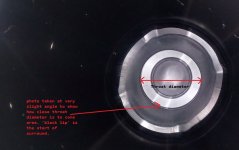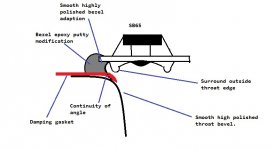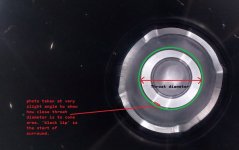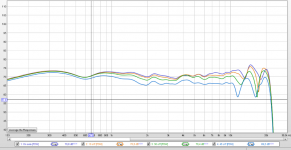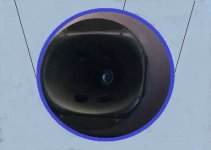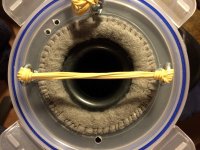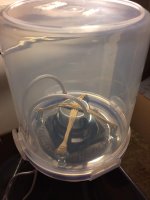I think for a home theater you want a constant directivity horn to cover multiple seats.
To take a CD horn and make it a synergy, it needs to have at least one nearly flat side to which you can epoxy a woofer.mounting board
There are more such horns available with 1.4" throats than with 2" throats, witness the Faital horns. There are even more horns with 1" throats (e.g. SEOS) but those require a 3-way Synergy solution.
What to look for? constant directivity, absence of diffraction slot, a good size and a 1.4" or 2" throat
I know Geddes hates diffraction horns, but I'm really warming up to them for Unity horns. A diffraction slot makes it a LOT easier to cross your compression driver over to your midranges.
For a conventional two-way, a diffraction slot is questionable, but for a Unity horn, it makes a lot of sense.
And note that you can have constant directivity with a diffraction slot.
BTW, the new Danley Jericho horn is a diffraction horn: New Danley Invention
That horn looks pretty good on paper. I think 8" is the largest woofer that can be fit to it and that might be a tight fit.
I think for a home theater you want a constant directivity horn to cover multiple seats.
To take a CD horn and make it a synergy, it needs to have at least one nearly flat side to which you can epoxy a woofer.mounting board
There are more such horns available with 1.4" throats than with 2" throats, witness the Faital horns. There are even more horns with 1" throats (e.g. SEOS) but those require a 3-way Synergy solution.
What to look for? constant directivity, absence of diffraction slot, a good size and a 1.4" or 2" throat
What about the 1,4" SEOS horns? Like the SEOS22 and higher? Size wise it would still work. Would a bit more expensive, but oh well.
I think for a home theater you want a constant directivity horn to cover multiple seats.
To take a CD horn and make it a synergy, it needs to have at least one nearly flat side to which you can epoxy a woofer.mounting board
There are more such horns available with 1.4" throats than with 2" throats, witness the Faital horns. There are even more horns with 1" throats (e.g. SEOS) but those require a 3-way Synergy solution.
What to look for? constant directivity, absence of diffraction slot, a good size and a 1.4" or 2" throat
I wish I had more time in the day. The Sound Physics Labs SPL-Runt is a two-way Unity Horn that uses a BMS 4550 1" compression driver and a pair of eights:
Two Way Synergy???
What about the 1,4" SEOS horns? Like the SEOS22 and higher? Size wise it would still work. Would a bit more expensive, but oh well.
The SEOS horns are great if you can get and afford the 1.4" versions. BWaslo's Small Syns use the 1" SEOS15. .
The SEOS horns are great if you can get and afford the 1.4" versions. BWaslo's Small Syns use the 1" SEOS15. .
They are definitely more expensive, but not so much that they are out of reach. Does mean that I cant just start cutting into one before I know what I'm doing 😉 Same for the K510 horn. Will start with that Faital (or other horn), a pair of 8" ers and a Faital HF140, and see where it gets me. After that I'll have more of an idea what I want and how possible it seems. A SEOS22 synergy as a height channel would be amazing lol. Why not skip the 22 and go straight for the SEOS30 or 24 hehe. Those are incredibly big and would look pretty weird up there near the roof though.
Have decided to try the 1,4" SEOS horns. Not sure which one, but depending on their weight I'll pick between the SEOS 18, 22 and 24. The 24 (550hz) is the one that can get close to my prefered crossover point (500hz). I'll open a seperate thread about the design. If there is any thread/website which could explain me step by step how to design/calculate all the design choices, I would love to hear it.
Hi All,
Very interesting to read about this experiment/speaker - So much in fact, that I want to try to make a similar build with the SB fullrange and 18-horn.
Regarding how to make the "throat" I am a bit confused.
Why make the roundover a tiny bit bigger than the surround and then cover it again with wool. Is this to make a smoother transition between the driver and the horn ie. no sharp edges?
On the picture of the actual driver in the horn, it looks like the driver inclusive dustcap, diaphragm and surround is visible from looking into the horn.
Is this not a discrepancy from the description of the picture?
I have copied two of the pictures from page 124 post 1248
Very interesting to read about this experiment/speaker - So much in fact, that I want to try to make a similar build with the SB fullrange and 18-horn.
Regarding how to make the "throat" I am a bit confused.
Why make the roundover a tiny bit bigger than the surround and then cover it again with wool. Is this to make a smoother transition between the driver and the horn ie. no sharp edges?
On the picture of the actual driver in the horn, it looks like the driver inclusive dustcap, diaphragm and surround is visible from looking into the horn.
Is this not a discrepancy from the description of the picture?
I have copied two of the pictures from page 124 post 1248
Attachments
Last edited:
Hi, that is not the surround you can see, it is the throat of the horn. The horn actually has a slight 'pinch to it that improves high freq dispersion (see 18sound website for pics).
The wool was my attempts at reducing a null when we first started experimenting. Getting the smooth transition was the most important bit.
Hope this helps.
The wool was my attempts at reducing a null when we first started experimenting. Getting the smooth transition was the most important bit.
Hope this helps.
In fact if you look at my photo,I have marked the actual throat diameter with the red arrow.
The large black ring beyond it is actually an optical illusion. It is a circular reflection of the dust cap.
The large black ring beyond it is actually an optical illusion. It is a circular reflection of the dust cap.
Hi Buschmeister, thanks for your reply.
I think I have figured it out know: When looking into the horn, it is only the area inside the surround that is visible (the green ring on the attached picture). But the actual routing of the horn is bigger - Outer diameter around 2,5 inches. To make room for the driver to breath?
Do you still own them today - If yes, how do you like them ?
If interested I can post measurements of my experiment (I own an Umik1 using REW)
Kind regards.
I think I have figured it out know: When looking into the horn, it is only the area inside the surround that is visible (the green ring on the attached picture). But the actual routing of the horn is bigger - Outer diameter around 2,5 inches. To make room for the driver to breath?
Do you still own them today - If yes, how do you like them ?
If interested I can post measurements of my experiment (I own an Umik1 using REW)
Kind regards.
Attachments
That's correct.
Yes I still have these speakers but I rehoused them into spherical enclosures:
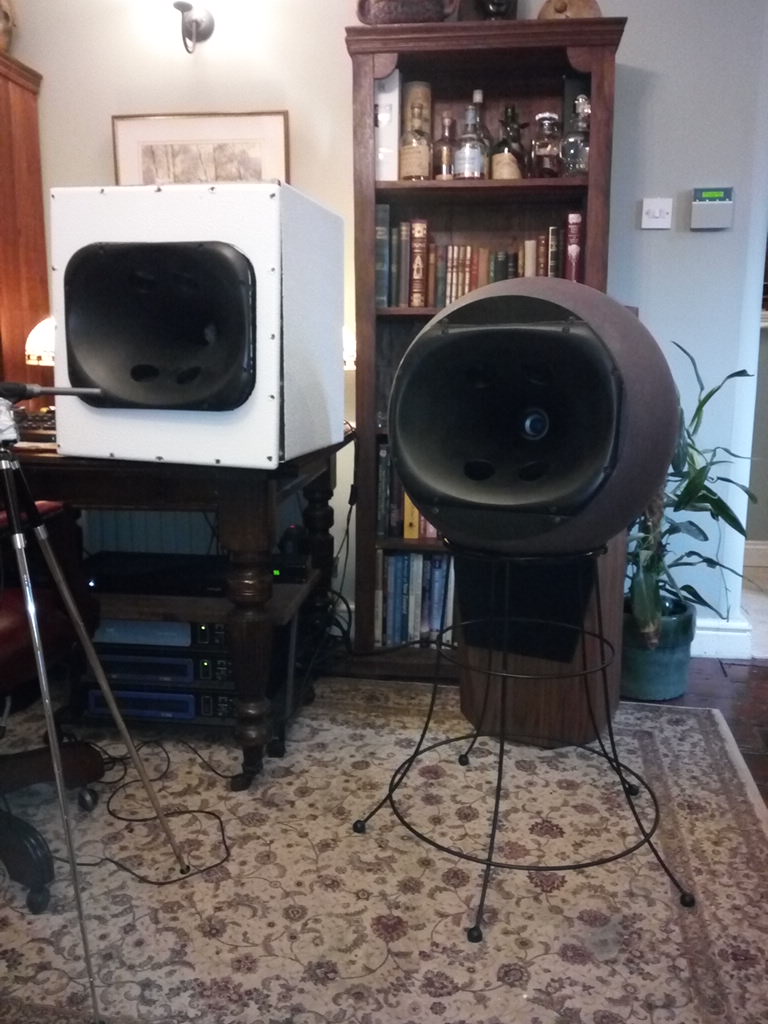
See this thread for the build:
The XBush Mark 2. A synergy/Unity horn of spherical proportions
They are amazing speakers - they don't need sub-woofers, and you can listen to them very near field or far field with very little change due to the point source summing. Of all the speakers I have made they are one of my favorites.
They must use a digital crossover to work though.
Currently I have one speaker that I tend to listen to more which is also spherical and designed to minimize diffraction. They aren't so good near field, but further out, they are simply amazing.
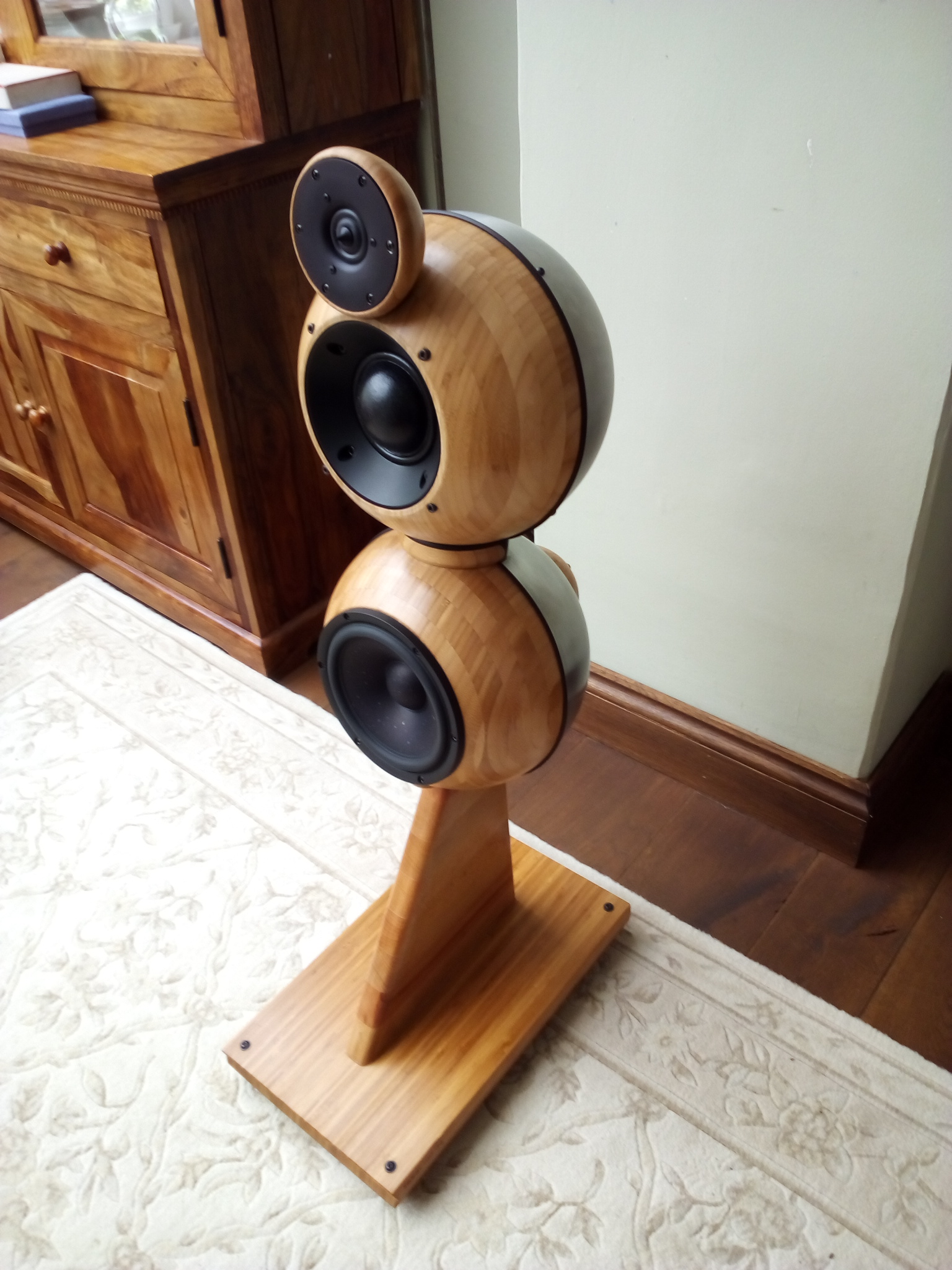
I don't know if this is the quality of the drivers, the lengths I went to to minimize diffraction, or because they are four way (rather than two way).
My next project is likely to be a line array, but I am awaiting space for this one!
Yes I still have these speakers but I rehoused them into spherical enclosures:

See this thread for the build:
The XBush Mark 2. A synergy/Unity horn of spherical proportions
They are amazing speakers - they don't need sub-woofers, and you can listen to them very near field or far field with very little change due to the point source summing. Of all the speakers I have made they are one of my favorites.
They must use a digital crossover to work though.
Currently I have one speaker that I tend to listen to more which is also spherical and designed to minimize diffraction. They aren't so good near field, but further out, they are simply amazing.

I don't know if this is the quality of the drivers, the lengths I went to to minimize diffraction, or because they are four way (rather than two way).
My next project is likely to be a line array, but I am awaiting space for this one!
EPIC build!!! Is the midrange in your new speaker a vintage ITT driver?
My plan is to build a 2 way. Either fullrange + woofer + woofer OR woofer + fullrange + woofer - Woofers will be SB Acoustics PFC 8" and 8 ohm woofers. On paper serious good performance and very cheap. None of the SB drivers have dissapointed me - quite the opposite.
Like you (if you still do) I use a miniDSP DA-8 - Amazing product I must say.
I received the horns the other day. Unfortunately i need a bigger routing bit to make the hole a little bit bigger. Regarding the transition to the horn I first tried with a ring of speakercable. That worked okay. Then I sew some handmade (not by me) wool around the speaker-cable. It works REALLY well. First simple crossover - 8th order LR filters at 550 Hz and 3 notches and a low-shelf filter. By no means perfect and I still need to put the SB65 in a box - But the sound is very open, LOW distortion and not harsh. A little on the bright side, but I believe that will be no problem after more EQ. The top-end is to high now
How did you EQ the fullrange-driver?
Attached is some rough measurements of the driver in the horn. The horn is flipped 90 degree - So kind of the vertical response - I plan to use it like that.
Maybe the response around 4-5 Khz will be better when I route the horn a little bit bigger. Clearly room for improvements - but not too bad I guess?
My plan is to build a 2 way. Either fullrange + woofer + woofer OR woofer + fullrange + woofer - Woofers will be SB Acoustics PFC 8" and 8 ohm woofers. On paper serious good performance and very cheap. None of the SB drivers have dissapointed me - quite the opposite.
Like you (if you still do) I use a miniDSP DA-8 - Amazing product I must say.
I received the horns the other day. Unfortunately i need a bigger routing bit to make the hole a little bit bigger. Regarding the transition to the horn I first tried with a ring of speakercable. That worked okay. Then I sew some handmade (not by me) wool around the speaker-cable. It works REALLY well. First simple crossover - 8th order LR filters at 550 Hz and 3 notches and a low-shelf filter. By no means perfect and I still need to put the SB65 in a box - But the sound is very open, LOW distortion and not harsh. A little on the bright side, but I believe that will be no problem after more EQ. The top-end is to high now
How did you EQ the fullrange-driver?
Attached is some rough measurements of the driver in the horn. The horn is flipped 90 degree - So kind of the vertical response - I plan to use it like that.
Maybe the response around 4-5 Khz will be better when I route the horn a little bit bigger. Clearly room for improvements - but not too bad I guess?
Attachments
Last edited:
That looks excellent to me!
I did find improvements can be made by making the throat transition as smooth as possible. But the SB65 works really well in that horn!
I use a miniDSP DA-8 with it just like you. I optimized the listening window at about 30 degrees at the listening position if I remember right, with a slight downward tilt about 5dB from 5000hz ish upwards - but this is all room dependent, positioning dependent and listening window dependent!
My advice is get the measurement nice at 1M, then move to position, and take a series of measurements (I usually do 8 positions in the listening window) to get a spacial average. Then adjust to taste!
The whole beauty of using a digital crossover is this room/position/personal preference adjustment. Which is utterly impossible with a premade speaker and crossover, and very difficult with a DIY passive speaker unless you have tons of components/time and don't mind making 20 passive crossovers!
In my mind DSP is the way forward - but that is only my humble opinion!
The midrange in my most recent speaker if the Volt VM752.
I did find improvements can be made by making the throat transition as smooth as possible. But the SB65 works really well in that horn!
I use a miniDSP DA-8 with it just like you. I optimized the listening window at about 30 degrees at the listening position if I remember right, with a slight downward tilt about 5dB from 5000hz ish upwards - but this is all room dependent, positioning dependent and listening window dependent!
My advice is get the measurement nice at 1M, then move to position, and take a series of measurements (I usually do 8 positions in the listening window) to get a spacial average. Then adjust to taste!
The whole beauty of using a digital crossover is this room/position/personal preference adjustment. Which is utterly impossible with a premade speaker and crossover, and very difficult with a DIY passive speaker unless you have tons of components/time and don't mind making 20 passive crossovers!
In my mind DSP is the way forward - but that is only my humble opinion!
The midrange in my most recent speaker if the Volt VM752.
I haven’t been here in a while - glad to see there is still interest. Based on Bushmeister’s build and data, I bought a set of the SB23NXRS45’s for my 2-way FAST. Haven’t put them on yet but couldn’t get over the quality of the low distortion Bushemeistwr presented.
Hi X, long time, hope you are well. Those SB23 drivers are excellent I don't think you will be disappointed.
I think the sorbothane magnet braces and horn loading may have helped with the measurements too though!
Keep us posted and your impressions.
I think the sorbothane magnet braces and horn loading may have helped with the measurements too though!
Keep us posted and your impressions.
you made it look like Sputnik.... now i'm reliving cold war fears from my youth....got check nothings coming over the north pole....
bushmeister: Thank you for your advice! I have recently started diving into Digital Room Correction. A huge topic.
I wonder if the specific crossoverslopes is made via biquads?
Sometimes I would like to be able to make passive crossovers - But the learning curve is way bigger than DSP. Also as you say, this project as with many other is not possible without DSP.
Nice driver in your most recent speaker ! - The reason I mentioned ITT is that it look quite like the old ITT lpkm 130 driver. Used in some of the very good speakers from back then. Tandberg Studio Monitor, Meridian and B&O.
I have made som advance regarding the horn.
First of all have made the throat a little bigger and as smooth as I could. Sanding up to grit 2500 with "wet-sanding-paper". The wool ring around was the simplest solution I could come up with. To rings of speakercables sewed together with thin wire. Then the wool sewed around it. My solution to mounting the driver is also quite simple, but I think it works well. See attached pictures.
The plasticbox is filled with thin felt and a piece of fill in the back. The volume is ca 1.5 Liters. Way bigger than nessesary - But the cheap boxes were fitting well...
I wonder if the specific crossoverslopes is made via biquads?
Sometimes I would like to be able to make passive crossovers - But the learning curve is way bigger than DSP. Also as you say, this project as with many other is not possible without DSP.
Nice driver in your most recent speaker ! - The reason I mentioned ITT is that it look quite like the old ITT lpkm 130 driver. Used in some of the very good speakers from back then. Tandberg Studio Monitor, Meridian and B&O.
I have made som advance regarding the horn.
First of all have made the throat a little bigger and as smooth as I could. Sanding up to grit 2500 with "wet-sanding-paper". The wool ring around was the simplest solution I could come up with. To rings of speakercables sewed together with thin wire. Then the wool sewed around it. My solution to mounting the driver is also quite simple, but I think it works well. See attached pictures.
The plasticbox is filled with thin felt and a piece of fill in the back. The volume is ca 1.5 Liters. Way bigger than nessesary - But the cheap boxes were fitting well...
Attachments
- Home
- Loudspeakers
- Multi-Way
- A Bookshelf Multi-Way Point-Source Horn
